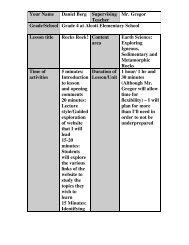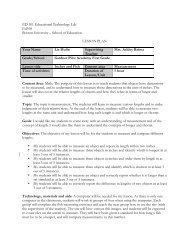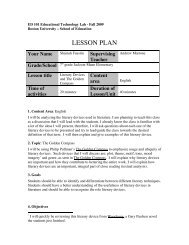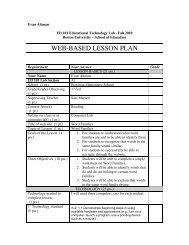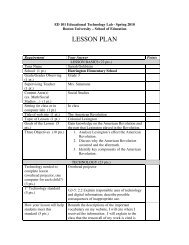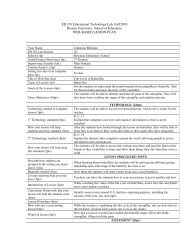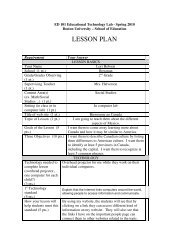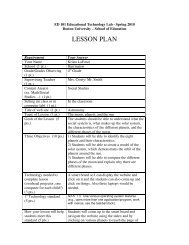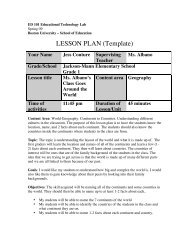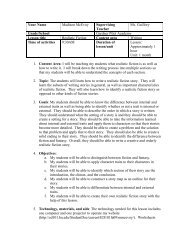LESSON PLAN (Template) - ED101 - Boston University
LESSON PLAN (Template) - ED101 - Boston University
LESSON PLAN (Template) - ED101 - Boston University
Create successful ePaper yourself
Turn your PDF publications into a flip-book with our unique Google optimized e-Paper software.
d. My students will demonstrate that the ends of magnets sometimes attract<br />
each other and repel each other by using two magnets and showing me or<br />
the teacher.<br />
e. My students will be able to realize what magnets can be used for in their<br />
school, home, and in the “grown-up” world and demonstrate this by<br />
bringing in a magnet to school and describing what it does outside of the<br />
classroom. This “grown-up” world is how magnets are used in jobs around<br />
the world.<br />
f. My students will be able to give two or more example of something that is<br />
a magnet even if it does not look like a typical magnet. For example, they<br />
will be able to realize that the letters that stick to their refrigerators have<br />
magnets on the back.<br />
g. My students will learn how to go back on the website to learn more about<br />
magnets and show their parents what they learned in school.<br />
5. Technology, Materials, and Aides: I will need one computer that is hooked up to<br />
some sort of projector. Then I would need a screen, Smartboard, or whiteboard to<br />
project the website onto. I would then need some magnets. The magnets will<br />
consist of two bar magnets, a plain black magnet, a refrigerator magnet, and two<br />
or three objects with a magnet on the back that do not look like typical magnets. I<br />
will also have similar things that are not magnets so the students can recognize<br />
what makes something a magnet. I will need objects that are attracted by magnets<br />
and ones that are not attracted by magnets. These will consist of nails, other<br />
magnets, a metal cup, a metal washer, and paper clips. I will also have things that<br />
are not attracted by magnets. These things will be paper, cloth, and a plastic water<br />
bottle. Some of these objects can be collected from the students prior to the<br />
lesson. For example, the students would be asked to bring in one thing they think<br />
can be picked up from a magnet and one thing that cannot be picked up by a<br />
magnet. These will then be discussed with the class as part of the lesson.<br />
6. Procedures/Methods:<br />
a. Overview: The lesson is basically going to be a back and forth discussion<br />
between the students and myself. I will be using the website as a<br />
slideshow for the lesson. I will show one of the pages and then explain<br />
what the page says to the students. Then I will do a “hands-onexperiment”<br />
with the students so they can understand the concept of what<br />
the slide is telling them.<br />
b. Introduction: My lesson will begin with a quick survey of the class to see<br />
what they know about magnets. The students will know what a refrigerator<br />
magnet is and they will be more than happy to tell me. I will explain to<br />
them that there are many different kinds of magnets and that they do<br />
different things. This will get the discussion started and lay the<br />
groundwork for the rest of the lesson.<br />
c. Activities:<br />
i. First slide: “What is a Magnet?” This slide will describe what a<br />
magnet is and what it does.



